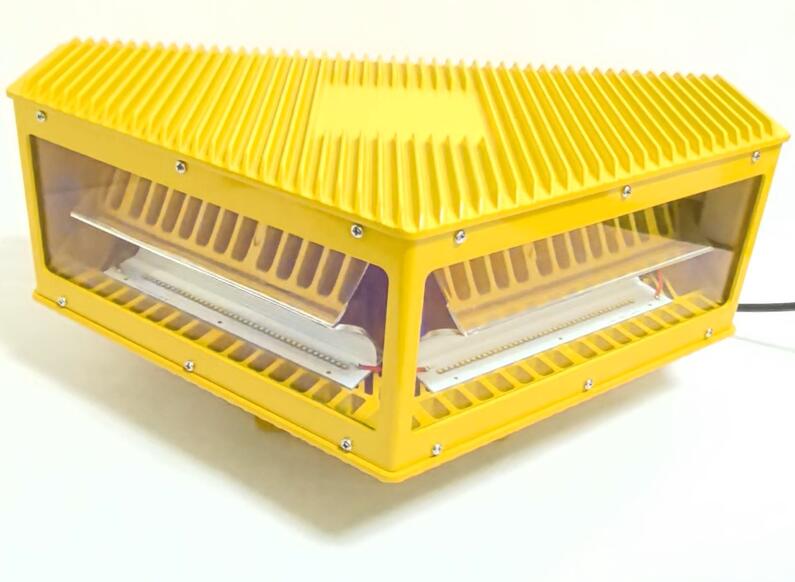Industrial chimneys, often towering hundreds of feet above the ground, pose a significant risk to low-flying aircraft. To mitigate this danger, chimney aircraft warning lights are installed to enhance visibility and prevent collisions. These specialized lights are essential for compliance with aviation safety regulations and play a critical role in protecting both aircraft and infrastructure. This article examines the purpose, types, regulatory requirements, and technological advancements of chimney aircraft warning lights, emphasizing their importance in modern aviation safety.
Why Chimney Aircraft Warning Lights Are Necessary
Chimneys, particularly those in power plants, refineries, and industrial facilities, are among the tallest structures in many regions. Without proper lighting, they can become hazardous obstacles for aircraft, especially during nighttime or poor weather conditions.

Key reasons for their necessity include:
Preventing Mid-Air Collisions: Ensures pilots can identify and avoid chimneys.
Regulatory Compliance: Mandated by aviation authorities worldwide.
Chimney Aircraft Warning Lights
|
Enhanced Visibility in Adverse Conditions: Helps aircraft navigate safely in fog, rain, or darkness.
Types of Chimney Aircraft Warning Lights
Different types of warning lights are used depending on chimney height, location, and aviation regulations. The most common systems include:
1. Low-Intensity Red Lights
Typically used on chimneys below 150 meters (492 feet).
Provide steady or flashing illumination.
Energy-efficient and suitable for areas with lower air traffic.
2. Medium-Intensity White Strobe Lights
Installed on chimneys between 150 and 300 meters (492–984 feet).
Chimney Aircraft Warning Light
|
High-visibility flashes detectable from long distances.
Ideal for regions with moderate air traffic.
3. High-Intensity White Strobe Lights
Required for chimneys exceeding 300 meters (984 feet).
Extremely bright, visible even in daylight.
Used near airports or in high-traffic flight paths.
4. Dual Lighting Systems
Combine red steady lights with white strobes for optimal visibility.
Often used in areas where both day and night operations require maximum safety.
Regulatory Standards for Chimney Aircraft Warning Lights
Aviation authorities enforce strict guidelines to ensure uniformity and effectiveness. Key regulatory bodies include:
Federal Aviation Administration (FAA) (USA): Specifies light intensity, placement, and flash rates.
International Civil Aviation Organization (ICAO): Provides global standards for obstacle lighting.
European Aviation Safety Agency (EASA): Regulates aviation safety in Europe, including chimney lighting.
Compliance ensures that chimneys do not become unseen hazards in flight paths.
Technological Innovations in Chimney Warning Lights
Advancements in lighting technology have improved the efficiency and reliability of chimney aircraft warning lights:
LED Technology: More energy-efficient, durable, and brighter than traditional incandescent bulbs.
Solar-Powered Systems: Reduce electrical dependency, ideal for remote industrial sites.
Remote Monitoring & Diagnostics: Allows real-time tracking of light functionality, reducing maintenance delays.
Installation and Maintenance Considerations
Proper installation and upkeep are crucial for ensuring continuous operation:
Placement: Lights must be positioned at the highest point and at intermediate levels if required.
Weather Resistance: Must withstand extreme temperatures, wind, and corrosive industrial emissions.
Regular Inspections: Ensures compliance and functionality, preventing regulatory penalties.
Chimney aircraft warning lights are indispensable for aviation safety, ensuring that industrial chimneys remain visible to pilots at all times. With evolving technologies like LED and smart monitoring systems, these lights are becoming more efficient and reliable. By adhering to international regulations and embracing innovation, industries can contribute to safer skies while protecting critical infrastructure.
As air traffic continues to grow, the role of chimney aircraft warning lights will only become more vital, reinforcing their importance in global aviation safety systems.

